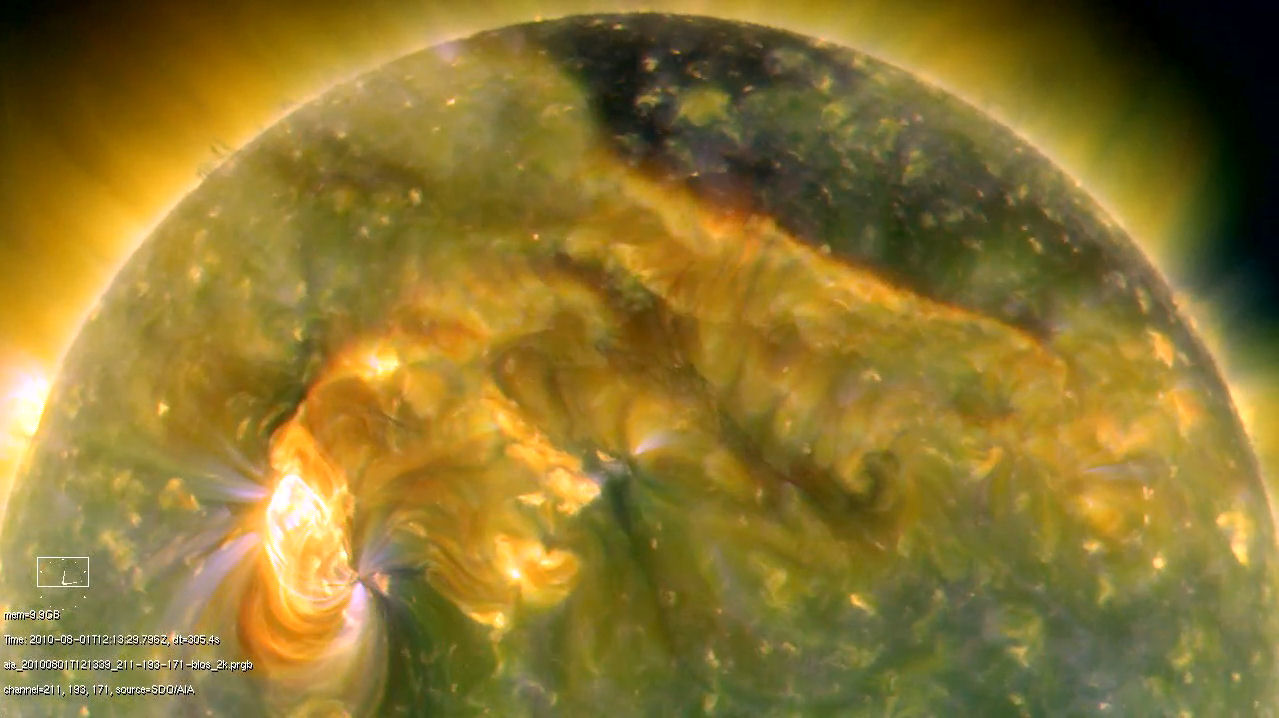8-31-10 - sunspot 1101 and 1102 - both quiet
Current conditions
Solar wind
speed: 332.2 km/sec
density: 0.4 protons/cm3
explanation |
more data
Updated: Today at 2345 UT
X-ray Solar Flares
6-hr max: B1 2245 UT Aug31
24-hr: B1 2245 UT Aug31
explanation
| more data
Updated: Today at: 2340 UT
AMAZING IMAGE OF JUPITER:
Last night, the atmosphere over Australia settled
into a state of rare, crystal-clear transparency -- and it did so
directly above the observatory of world-famous astrophotographer Anthony
Wesley. The result was
a picture of Jupiter that some onlookers are calling the finest-ever
by an amateur astronomer. "On a scale of 1 to 10, the seeing was a 12,"
says Wesley. "Now I know what it must be like to see the giant planet
from space."
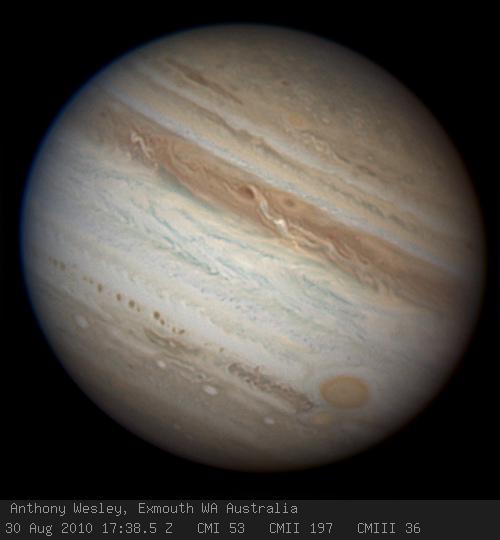
BIG ERUPTION:
On August 24th and 25th, an enormous
magnetic filament slowly rose off the surface of the sun and erupted.
Stationed over the sun's western hemisphere, NASA's STEREO-A spacecraft
was in perfect position to record the action. Click on the arrow to play
a 30-hour time lapse movie:
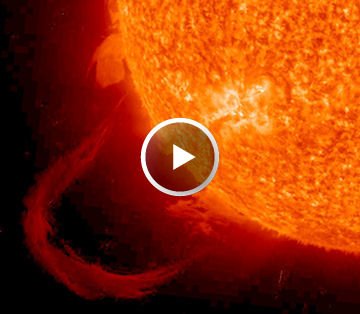
movie formats:
13 MB
Quicktime;
4 MB
iPad,
1.7 MB
iPhone
The horseshoe-shaped filament expanded
and -popped- about 600,000 km above the stellar surface. Rather than
flying off toward Earth, however, most of the hot glowing plasma the
filament contained simply fell back to the sun. There will be no
Earth-effects from the blast.
|
8-30-10 sunspots 1101 and 1102 - both quiet
Current conditions
Solar wind
speed: 394.2
km/sec
density: 0.1 protons/cm3
explanation |
more data
Updated: Today at 1647 UT
X-ray Solar Flares
6-hr max: B1 1220 UT Aug30
24-hr: B1 1220 UT Aug30
explanation
| more data
Updated: Today at: 1645 UT
|
8-29-10 sunspots 1101 and 1102 - btth quiet
Current conditions
Solar wind
speed: 439.1 km/sec
density: 0.1 protons/cm3
explanation |
more data
Updated: Today at 2345 UT
X-ray Solar Flares
6-hr max: A7 1945 UT Aug29
24-hr: A7 1945 UT Aug29
explanation
| more data
Updated: Today at: 2340 UT
|
8-28-10 sunspot 1101 - quiet
Current conditions
Solar wind
speed: 542.2 km/sec
density: 0.1 protons/cm3
explanation |
more data
Updated: Today at 2347 UT
X-ray Solar Flares
6-hr max: A7 2110 UT Aug28
24-hr: A9 0050 UT Aug28
explanation
| more data
Updated: Today at: 2340 UT
SPLASHES OF GREEN: For the third day in a row, a
high-speed solar wiind stream is buffeting Earth's magnetic field,
energizing bright auroras around the Arctic Circle. "There was quite a
heavy outburst last night (Aug. 27)," reports Bernt Olsen from Kvaløya,
Norway. "Even though the arctic nights still are bright, we could still
see splashes of green in the sky."
NOAA forecasters estimate a 30% chance of geoomagnetic
activity during the next 24 hours as the solar wind continues to blow.
High-latitude sky watchers should remain alert for auroras.
August 2010 Northern Lights Gallery
[previous Augusts:
2009,
2008,
2007,
2006,
2005,
2004,
2003]
|
8-27-10 sunspot 1101 - still quiet
Current conditions
Solar wind
speed: 664.6 km/sec
density: 0.2 protons/cm3
explanation |
more data
Updated: Today at 2006 UT
X-ray Solar Flares
6-hr max: B1 1640 UT Aug27
24-hr: B4 0440 UT Aug27
explanation
| more data
Updated: Today at: 2000 UT
FIRST LIGHT FROM THE NEW SOLAR TELESCOPE:
Before you read another word, click on the
image and take a close look at sunspot 1084:
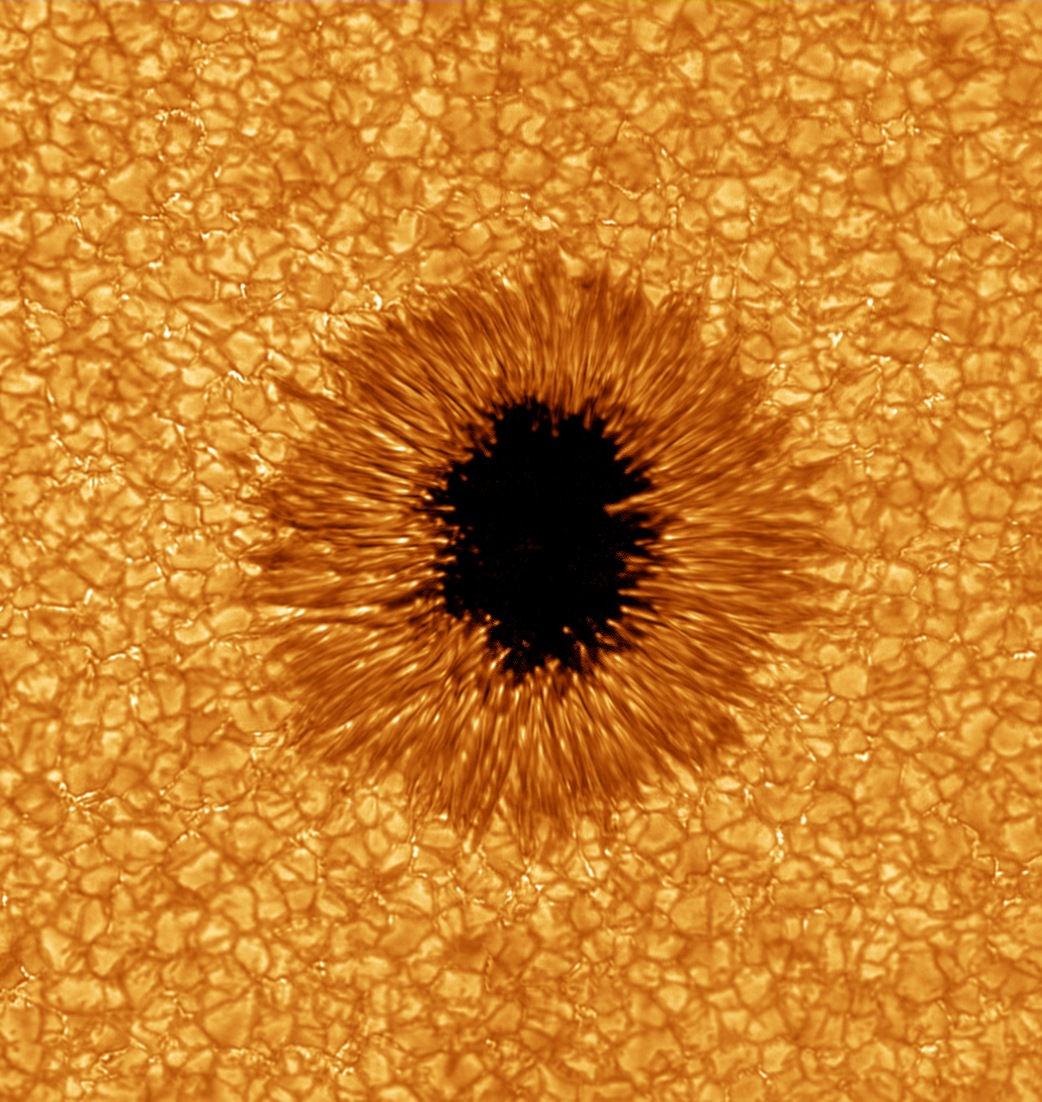
T his is a
first light
adaptive optics image from the
New Solar Telescope (NST) at the Big Bear Solar Observatory in
California. "With a 1.6-meter primary mirror, the NST is the largest
solar telescope in the world," says Nicolas Gorceix of the observatory
staff. "It has realtime correction for atmospheric distortion (adaptive
optics), so we can see things in very high resolution--as small as 65 km
wide on the sun."
"For perspective," he adds, "Earth is slightly smaller
than the whole sunspot including the dark umbra and the daisy petal-like
penumbra. The spot is surrounded by the sun's ubiquitous granular field
[which shows the boiling motions of the sun's surface]."
Researchers believe that high-resolution studies of
sunspots can help them understand how sunspots evolve and anticipate
when they're about to erupt. "Next year, we plan to upgrade the
telescope with a much higher-order adaptive optics system to get even
better images," says Gorceix. Stay tuned to the
BBSO home page for updates.
|
8-26-19 sunspot 1101 - very quiet
Current conditions
Solar wind
speed: 612.1 km/sec
density: 0.3 protons/cm3
explanation |
more data
Updated: Today at 1216 UT
X-ray Solar Flares
6-hr max: B2 1050 UT Aug26
24-hr: B2 1050 UT Aug26
explanation
| more data
Updated: Today at: 1215 UT
SMALLEST FULL MOON OF THE YEAR:
If you thought this week's full Moon looked a bit
small, you were right. It was the smallest full Moon of the year.
Anthony Ayiomamitis of Athens, Greece, offers this comparison:
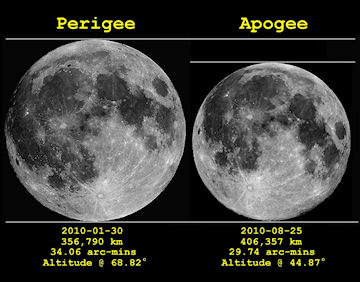
It shows the largest full Moon of the year (Jan. 30) vs.
the smallest (Aug. 25th). "The difference between the two full moons is
around 14.5% and certainly easily noticeable by the naked eye," says
Ayiomamitis.
Johannes Kepler explained the difference
401 years ago: The Moon's orbit around Earth
is an ellipse. One side of the orbit (perigee) is 50,000 km closer to
Earth than the other (apogee). The full Moon of Aug. 25th was a distant
apogee Moon, and that's why it looked so small.
|
8-25-10 sunspot 1101
Current conditions
Solar wind
speed: 663.6 km/sec
density: 0.4 protons/cm3
explanation |
more data
Updated: Today at 2345 UT
X-ray Solar Flares
6-hr max: A7 2205 UT Aug25
24-hr: A7 2205 UT Aug25
explanation
| more data
Updated: Today at: 2340 UT
FULL MOON: How can
you tell this Moon is full? Is it the enormous disk? The glaring
moonlight? No. The real clue is the orange color of the office windows.
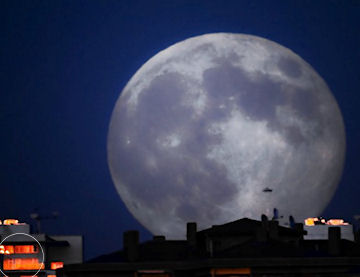
"The orange light in the windows is reflection of the
sunset," explains photographer M. Raşid Tuğral of Ankara, Turkey. "The
sun and Moon were on opposite sides of the sky--the defining geometry of
a full Moon!"
Last night's sun-Moon geometry attracted the attention
of photographers around the world. Browse the links for more
examples:
from Stefano De Rosa of Isola d' Elba, Italy;
from Tamás Ábrahám of Tök, Hungary;
from Tamas Ladanyi of Veszprem, Hungary;
from Mohammad Rahimi of Esfahan, Iran;
from George Kristiansen of Upton,
Lincolnshire, UK;
from Fredrik Broms of Kvaløya, Norway;
from Christophe Stolz of Riggisberg,
Switzerland;
from Alan Dyer of Dinosaur Provincial Park,
Alberta, Canada
[ EDITOR'S NOTE: I can't figure out
how the moon is so large in these photographs and when I take a photo,
you can barely find the moon in the photo because its so small.
|
8-24-10 No sunsoits today
What is this?
http://stereo-ssc.nascom.nasa.gov/browse/2010/08/24/ahead/cor2/2048/20100824_090935_n7c2A.jpg
Pretty stars in a row - what is it?
Current conditions
Solar wind
speed: 679.4 km/sec
density: 2.6 protons/cm3
explanation |
more data
Updated: Today at 1456 UT
X-ray Solar Flares
6-hr max: A5 1255 UT Aug24
24-hr: A6 0820 UT Aug24
explanation
| more data
Updated: Today at: 1445 UT
|
8-23-10 no sunspots today
Current conditions
Solar wind
speed: 400.9 km/sec
density: 19.4 protons/cm3
explanation |
more data
Updated: Today at 2345 UT
X-ray Solar Flares
6-hr max: A5 2230 UT Aug23
24-hr: A6 0335 UT Aug23
explanation
| more data
Updated: Today at: 2340 UT
FIREBALL ON JUPITER: On August 20th at 18:22 UT,
amateur astronomer Masayuki Tachikawa of Kumamoto city, Japan,
video-recorded an apparent impact on Jupiter. Click on the image to view
a movie of the fireball:
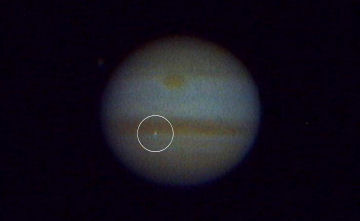
This is the third time in only 13 months that amateur
astronomers have detected signs of impact on Jupiter. The earlier events
occured on
July 19, 2009, and
June 3, 2010. This weekend's impact, if that's what it was, has not
been confirmed by multiple observers, but it resembles the
uncontroversial impact of June 3, 2010, and appears to be genuine.
"Like the event of June 3rd, this fireball did not
produce any visible debris," notes John Rogers, director of the British
Astronomical Association's Jupiter section. "Here
are some hi-resolution images taken 1-2 rotations before and 1-2
rotations after the event. As the observers commented, there was no
visible mark (not in RGB, nor UV, nor methane), post-impact. Dark brown
spots on the North Equatorial Belt were already there before the
fireball."
ANTARCTIC DRIVE-IN THEATRE: Where do you go to
see a movie in Antarctica? The drive-in theatre, of course. Michael
Zupanc reports from Australia's Davis Station on the Antarctic coast:
"We made our our own drive-in threatre by clearing some snow off the sea
ice and using a nearby cliff as the movie screen." On August 7th there
was a double feature--the
Blues Brothers and the aurora australis:
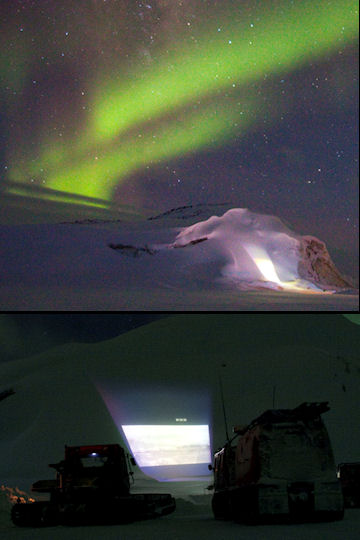
"It was a nice, clear night and the auroras provided excellent mood
lighting for Jake and Elwood," says Zupanc.
We hope they're in the mood for more. A solar wind stream is heading
for Earth and it could spark a new round of geomagnetic activity when it
arrives on August 25th. High-latitude sky watchers should
remain alert for auroras.
August 2010 Northern Lights Gallery
[previous Augusts:
2009,
2008,
2007,
2006,
2005,
2004,
2003]
|
8-22-10 - no sunspots today
Current conditions
Solar wind
speed: 259.4 km/sec
density: 1.3 protons/cm3
explanation |
more data
Updated: Today at 1831 UT
X-ray Solar Flares
6-hr max: A5 1300 UT Aug22
24-hr: A7 0110 UT Aug22
explanation
| more data
Updated: Today at: 1830 UT
CORONAL HOLE: A coronal hole on the sun is
turning to face Earth. Coronal holes are places in the sun's atmosphere
where the magnetic field opens up and allows solar wind to escape. Here
is a magnetic map of the hole from NASA's Solar Dynamics Observatory:
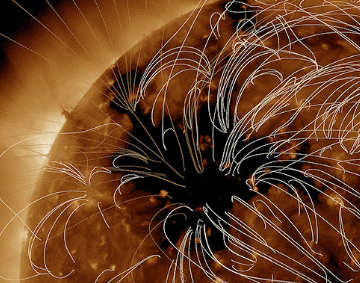
Image credit: Karel Schrijver, Lockheed Martin SAL
In the image, magnetic field lines are color-coded. White field lines
are closed; they hold the solar wind in. Golden-brown field lines are
open; they allow the solar wind out.
A stream of solar wind flowing from this coronal hole is expected to
reach Earth on August 24th or 25th. High-latitude sky watchers should
be alert for
auroras when it arrives.
|
8-21-10 - no sunspots
Current conditions
Solar wind
speed: 284.8 km/sec
density: 2.1 protons/cm3
explanation |
more data
Updated: Today at 2323 UT
X-ray Solar Flares
6-hr max: A6 1855 UT Aug21
24-hr: A9 0000 UT Aug21
explanation
| more data
Updated: Today at: 2340 UT
http://www.theepochtimes.com/n2/content/view/41327/
Neptune will finally complete its first full orbit of the sun since it
was discovered in 1846—approximately one year from now, according to
NASA estimates.
A recent Space.com article incorrectly slated the completion of
Neptune’s orbit for August 20, 2010, bringing the topic into the public
arena ahead of time. The story has since been updated to reflect the
actual date exactly a year later.
Neptune is a gas planet and farthest from the sun. It appears very tiny
using a normal telescope, typically requiring observers to use
sophisticated binoculars or telescopes to view it. Uranus is usually
easier to find using the naked eye.
To the extra keen observer, Neptune should be visible when it completes
its orbit on August 20, 2011. “Look for the large but faint triangle of
Capricornus, to the left of Sagittarius and the Milky Way. The two
stars at the left end of the triangle point the way to Neptune, just a
little bit short of and above the star Iota in the neighboring
constellation Aquarius," advised Space.com.
Like Saturn, Neptune also has rings, but they are very faint compared
to Saturn’s signature rings. Neptune has very high winds which can
travel at supersonic speeds, and has 13 moons.
The planet has an interesting history. In 1781, Uranus was discovered
by Sir William Herschel. However astronomers were puzzled by Uranus’
position, and predicted gravity from another planet was interfering
with Uranus’ motion.
Then, in the mid-1840s, Englishman John Couch Adams and Frenchman
Urbain Le Verrier pinpointed this new planet's location. However, most
astronomers still did not take any notice.
Finally, on Sept. 23, 1846, German astronomer Johann Galle found the
planet when observing this predicted location in space. He shares the
honor of discovering Neptune with Adams and Verrier.
However, Galle was not really the first person to have found Neptune,
but rather the first to realise what he had found. Galileo Galilei
mistook Neptune as a star twice on Dec. 28, 1612 and Jan.27, 1613,
during his studies of the night sky.
|
8-20-10 - No sunspots
Current conditions
Solar wind
speed: 322.0 km/sec
density: 3.3 protons/cm3
explanation |
more data
Updated: Today at 0906 UT
X-ray Solar Flares
6-hr max: A8 0415 UT Aug20
24-hr: A8 0415 UT Aug20
explanation
| more data
Updated: Today at: 0900 UT
|
8-19-10 sunspot 1098 and 1100 are very small
and quiet
Current conditions
Solar wind
speed: 351.0 km/sec
density: 3.7 protons/cm3
explanation |
more data
Updated: Today at 2346 UT
X-ray Solar Flares
6-hr max: B3 2225 UT Aug18
24-hr: C4 0545 UT Aug18
explanation
| more data
Updated: Today at: 2340 UT
FARSIDE ERUPTION: This morning around 0500 UT,
something exploded on the far side of the sun. NASA's STEREO-A
spacecraft had
a direct view of the blast, which produced a C4-class solar flare
and hurled a bright coronal mass ejection (CME) over the sun's western
limb:
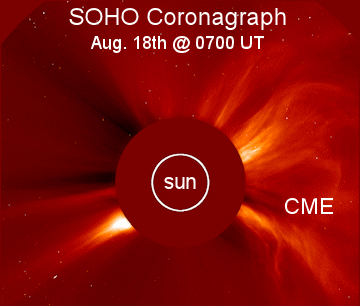
Click to view a 0.7 MB movie of the CME
Based on STEREO-A imagery, the source of the eruption
appears to be farside sunspot complex 1093-1099. Magnetic fields
connecting the two sunspot groups became unstable and--bang! The blast
was not directed toward Earth, so no geomagnetic storms are in the
offing.
more images:
from NASA's Solar Dynamics Observatory (SDO) in Earth orbit
RED SPOTS IN CONJUNCTION: What
happens when a raging cyclone as wide as Earth bumps into another storm
twice as large? The answer lies in the midnight sky. Two storms on
Jupiter--the
Great Red Spot and
Oval BA--are having just such a close encounter. Amateur astronomer
Anthony Wesley sends this picture from Exmouth, Australia:
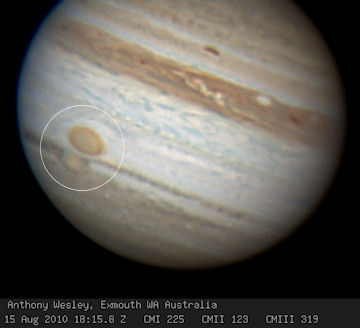
The bigger storm is the Great Red Spot, which has been
swirling around Jupiter for centuries. The smaller is upstart Oval BA,
which formed less than ten years ago. Because the storms travel around
Jupiter at different rates, they pass one another periodically,
approximately every two years. And when they do ... not much happens.
Previous encounters have shown, surprisingly, that the two colossal
storms can converge and emerge in tact. Could this time be different?
"Oval BA and the Great Red Spot will be passing one
another in the days ahead," says Wesley. "I plan to monitor
developments."
more images:
from Brian Combs of Buena Vista, GA;
from Efrain Morales Rivera of Aguadilla, Puerto Rico;
from Ralf Vandebergh of the Netherlands
|
8-17-10 sunspot 1099
Current conditions
Solar wind
speed: 384.2 km/sec
density: 6.6 protons/cm3
explanation |
more data
Updated: Today at 2345 UT
X-ray Solar Flares
6-hr max: C1 2335 UT Aug17
24-hr: C1 2335 UT Aug17
explanation
| more data
Updated: Today at: 2340 UT
GREEN SNOW: Tonight's weather forecast in
Antarctica calls for a 35% chance of green snow. Yes, green. It turns
that color during geomagnetic storms, as shown in this August 1st photo
from Nick Roden of Australia's
Davis
Station on the Antarctic coast:
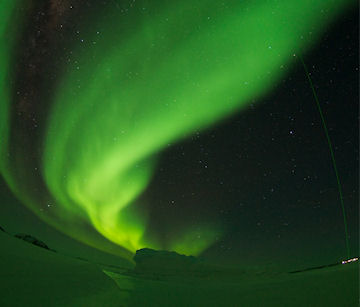
"We've had some fantastic aurora displays lately--bright
enough to reflect from the snow," says Roden. In addition to the green
auroras, there is also
a green laser lancing up from the research station in the
background. "That's our LIDAR, which we use to study the upper
atmosphere."
A new episode of green may be in the offing. A coronal
mass ejection (CME) is expected to deliver a glancing blow to Earth's
magnetic field on Aug. 17th or 18th, and NOAA forecasters estimate a 35%
chance of polar geomagnetic activity when the cloud arrives.
August 2010 Northern Lights Gallery
[previous Augusts:
2009,
2008,
2007,
2006,
2005,
2004,
2003]
August 16, 2010: For the next few months,
Venus will be softly resplendent in the evening sky, a treat for
stargazers – but looks can be deceiving.
Consider this: The Venusian surface is hot enough to melt lead. The
planet's 96% carbon dioxide atmosphere is thick and steamy with a
corrosive mist of sulfuric acid floating through it. The terrain is
forbidding, strewn with craters and volcanic calderas – and bone dry.
Takeshi Imamura can't wait to get there.
Imamura is the project scientist for Akatsuki, a Japanese mission
also called the Venus Climate Orbiter. The spacecraft is approaching
Venus and will enter orbit on December 7, 2010. Imamura believes a
close-up look at Venus could teach us a lot about our own planet.
"In so many ways, Venus is similar to Earth. It has about the same
mass, is approximately the same distance from the sun, and is made of
the same basic materials," says Imamura. "Yet the two worlds ended up so
different. We want to know why."
Although a parade of U.S. and Soviet spacecraft has visited Venus
since 1961, no one yet knows how it became Earth's "evil twin." Did it
suffer from a case of global warming run amok – or something else? When
Akatsuki reaches Venus in December, it will begin to solve some of the
mysteries hidden in the thick Venusian atmosphere.
"By comparing Venus's unique meteorology to Earth's, we'll learn more
about the universal principles of meteorology and improve the climate
models we use to predict our planet's future."
Particularly puzzling is Venus's "super-rotation." Fierce,
blistering winds propel an atmosphere filled with storms and sulfuric
acid clouds in a churning maelstrom around Venus at over 220 miles per
hour, 60 times faster than the planet itself rotates.
"Venus's atmosphere is in perpetual motion, as if a living thing,"
says Imamura.
Within this swirling cauldron are other Venusian riddles to be
solved: What is the origin of the 12-mile thick layer of sulfuric acid
clouds that shrouds the planet? And how does Venus' lightning crackle
through this strange brew?
Akatsuki, bristling with cameras, will circle the exotic planet's
equator in an elliptical orbit for at least 2 years, monitoring the
atmosphere at different altitudes using various wavelengths (IR, UV, and
visible). With this data and data from the spacecraft's radio dish,
scientists will reconstruct a 3D model of the atmosphere's structure and
dynamics.
"The spacecraft's orbit will match the circulation of Venus's clouds,
allowing the instruments to monitor cloud movement from directly above
for 20 hours at a time. We'll assemble the images to produce a cloud
motion time-lapse movie, much like a weather forecaster on television
might show you of Earth."
The instruments will also scrutinize the planet's surface for
volcanic activity that could be contributing to the sulfur contents of
the atmosphere. "If any active volcanoes are spouting hot lava on Venus,
one of our infrared cameras will detect the thermal emission," says
Imamura.
In addition, Akatsuki's Lightning and Airglow Camera will hunt for
lightning in order to settle a longstanding debate. "On Earth, the
standard theory of lightning requires water ice particles on which
positive or negative charges are induced via collisions," explains
Imamura. "But there are no ice particles in Venus's hot, dry
atmosphere--so how does Venusian lightning get started? It may be that
charge separation can occur in sulfuric acid clouds--or perhaps some
unknown solid particles exist in the atmosphere and play an important
role."
Imamura can scarcely contain his curiosity. "As a young boy I loved
to watch clouds, stars, oceans, rocks, and creatures. I wanted to
understand why they look and behave as they do. Now I am curious in the
same way about Venus. Nature is so full of mysteries!"
Beginning in December, some of Venus's mysteries will be revealed.
Stay tuned.
Author:
Dauna Coulter | Editor:
Dr. Tony Phillips | Credit: Science@NASA
| More Information |
|
Venus Climate Orbiter (Akatsuki) -- JAXA home page
Akatsuki is the Japanese word for "dawn."
The European Space Agency's Venus Express is already circling
Venus in a polar orbit, performing a global investigation of the
Venusian atmosphere and of the plasma environment. This
spacecraft is using spectrometers to examine the atmosphere's
chemistry. "Together, these two spacecraft will yield more
information than either spacecraft could produce alone," says
Imamura. "For example, we'll be able to trace the circulations
of chemicals in Venus's atmosphere that determine its chemical
state."
|
Have Venus volcanoes been caught in the act?
Astronomers have speculated for decades about active volcanoes on
Venus. Do volcanoes erupt beneath Venus’ clouds?
Six years of observations by ESA’s Venus Express have shown large
changes in the sulphur dioxide content of the planet’s atmosphere,
and one intriguing possible explanation is volcanic eruptions.
The thick atmosphere of Venus contains over a million times as
much sulphur dioxide as Earth’s, where almost all of the pungent,
toxic gas is generated by volcanic activity.
Most of the sulphur dioxide on Venus is hidden below the planet’s
dense upper cloud deck, because the gas is readily destroyed by
sunlight.
That means any sulphur dioxide detected in Venus’ upper
atmosphere above the cloud deck must have been recently supplied
from below.
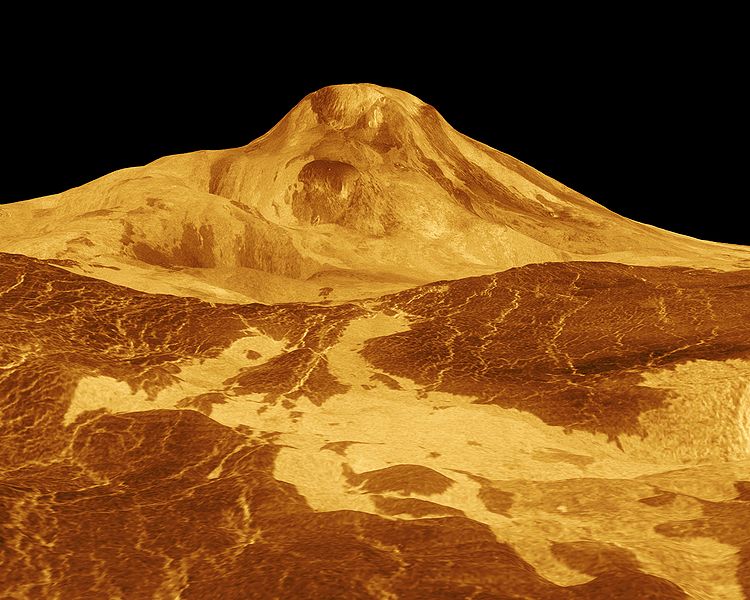
This is Maat Mons, the tallest volcano on Venus, rising 8 kilometers (5
miles) above the plains. The Magellan spacecraft revealed evidence for
comparatively recent volcanic activity at Maat Mons, in the form of ash
flows near the summit and on the northern flank. Now ESA’s Venus Express
has shown changes in the sulphur dioxide content of Venus’ atmosphere.
Could this be a sign of active volcanoes on Venus? Image based on
Magellan probe radar images
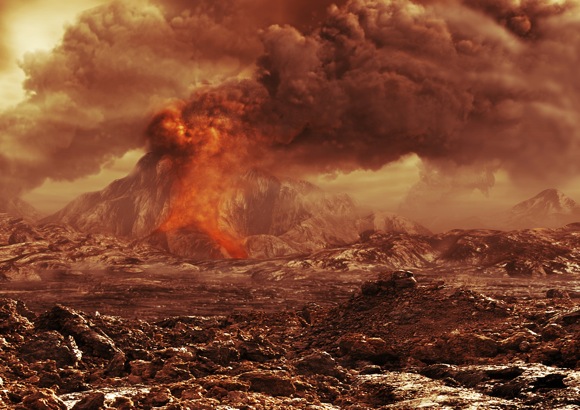
Artist’s impression of an active volcano on
Venus. Credits: ESA/AOES
Venus is covered in hundreds of volcanoes, but whether they remain
active today is much debated, providing an important scientific goal for
Venus Express.
The mission has already found clues pointing to volcanism on
geologically recent timescales, within the last few hundreds of
thousands to millions of years.
A previous analysis of infrared radiation from the surface pointed to
lava flows atop a volcano with a composition distinct from those of
their surroundings, suggesting that the volcano had erupted in the
planet’s recent past.
Now, an analysis of sulphur dioxide concentration in the upper
atmosphere over six years provides another clue.
Immediately after arriving at Venus in 2006, the spacecraft recorded
a significant increase in the average density of sulphur dioxide in the
upper atmosphere, followed by a sharp decrease to values roughly ten
times lower by today.
A similar fall was also seen during NASA’s Pioneer Venus mission,
which orbited the planet from 1978 to 1992.
At that time, the preferred explanation was an earlier injection of
sulphur dioxide from one or more volcanoes, with Pioneer Venus arriving
in time for the decline.
“If you see a sulphur dioxide increase in the upper atmosphere, you
know that something has brought it up recently, because individual
molecules are destroyed there by sunlight after just a couple of days,”
says Dr. Emmanuel Marcq of Laboratoire Atmosphères, Milieux,
Observations Spatiales, France, and lead author of the paper published
in Nature Geoscience.
“A volcanic eruption could act like a piston to blast sulphur dioxide
up to these levels, but peculiarities in the circulation of the planet
that we don’t yet fully understand could also mix the gas to reproduce
the same result,” adds co-author Dr. Jean-Loup Bertaux, Principal
Investigator for the instrument on Venus Express that made the
detections.
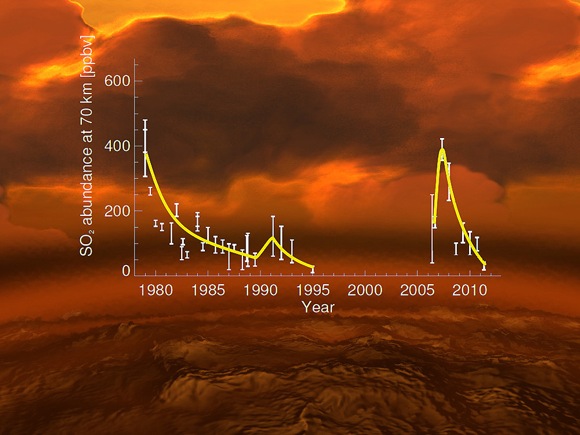
The rise and fall of sulphur dioxide in the upper
atmosphere of Venus over the last 40 years, expressed in units of
parts per billion by volume (ppbv). Credits: Data: E. Marcq et al.
(Venus Express); L. Esposito et al. (earlier data); background
image: ESA/AOES
Venus has a ‘super-rotating’ atmosphere that whips around the planet
in just four Earth-days, much faster than the 243 days the planet takes
to complete one rotation about its axis.
Such rapid atmospheric circulation spreads the sulphur dioxide
around, making it difficult to isolate any individual points of origin
for the gas.
Dr. Marcq’s team speculate that if volcanism was responsible for the
initial increase, then it could come from a relatively gentle increased
output of several active volcanoes rather than one dramatic eruption.
“Alternatively, and taking into account the similar trend observed by
Pioneer Venus, it’s possible that we are seeing decadal-scale
variability in the circulation of the atmosphere, which is turning out
to be even more complex than we could ever have imagined,” he notes.
“By following clues left by trace gases in the atmosphere, we are
uncovering the way Venus works, which could point us to the smoking gun
of active volcanism,” adds Håkan Svedhem, ESA’s Project Scientist for
Venus Express.
|
8-16-10 sunspot 1099
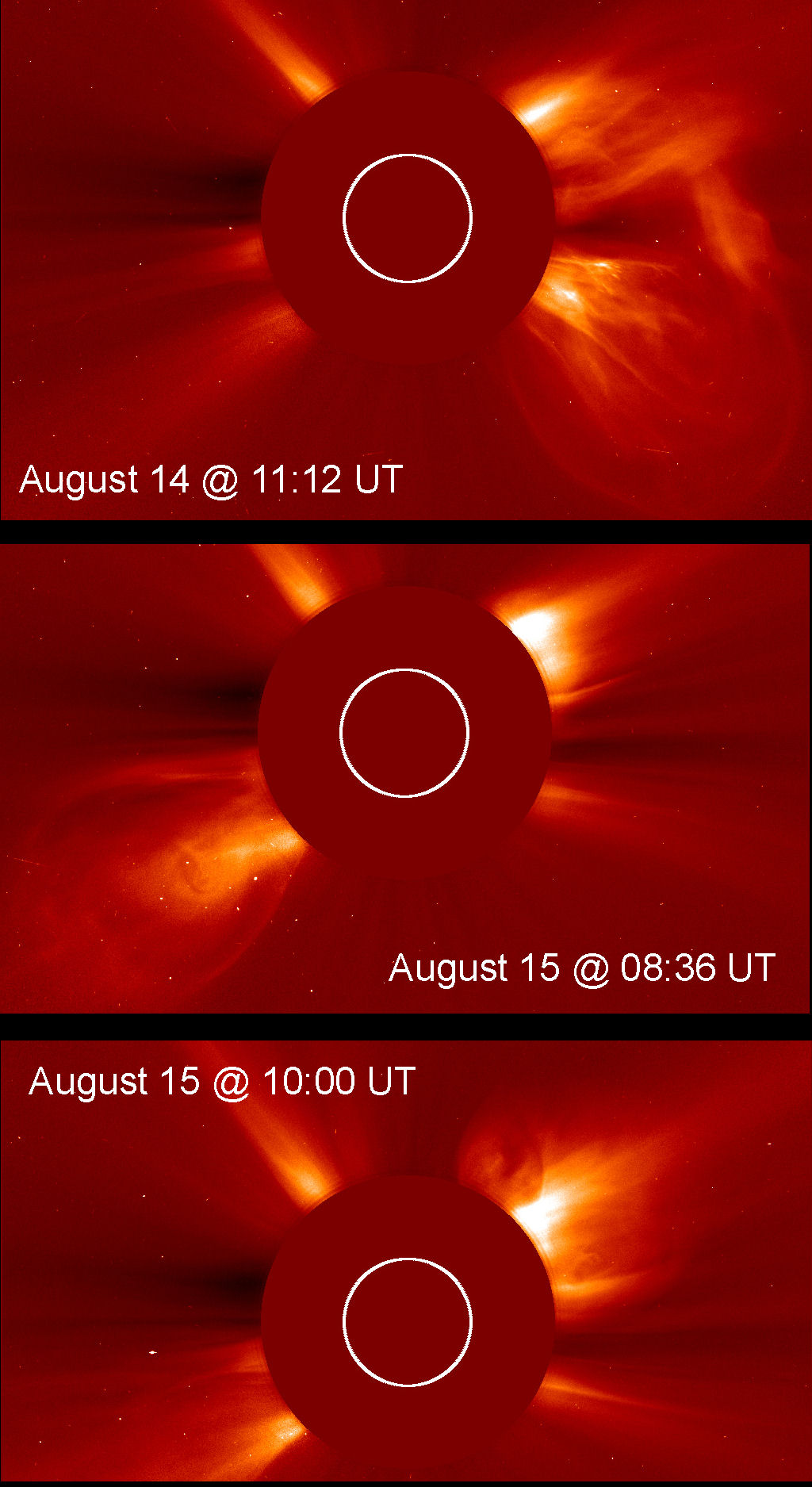
Current conditions
Solar wind
speed: 373.6 km/sec
density: 2.9 protons/cm3
explanation |
more data
Updated: Today at 2345 UT
X-ray Solar Flares
6-hr max: B3 1815 UT Aug16
24-hr: C1 1640 UT Aug16
explanation
| more data
Updated: Today at: 2340 UT
|
8-15-10 sunspots 1093 and 1099
CME ACTIVITY: The sun has produced three bright
coronal mass ejections (CMEs) this weekend. None is heading directly for
Earth, although the CME of Aug. 14th might deliver a glancing blow to
Earth's magnetic field on August 17th.
Click here for CME snapshots fro the Solar and Heliospheric
Observatory (SOHO).
PERSEID RECAP: According to the
International Meteor Shower, the Perseid meteor shower peaked on August
12th around 1800 UT with a maximum of
117 meteors per hour
(ZHR). The nearly new Moon provided dark skies for excellent viewing, so
the shower was widely observed. Browse the
updated gallery for snapshots from around the world.
Current conditions
Solar wind
speed: 356.4 km/sec
density: 2.9 protons/cm3
explanation |
more data
Updated: Today at 2345 UT
X-ray Solar Flares
6-hr max: C4 1830 UT Aug15
24-hr: C4 1830 UT Aug15
explanation
| more data
Updated: Today at: 2340 UT
ONOSPHERIC DISTURBANCE: The C4-class solar flare
of Aug. 14th bathed Earth's upper atmosphere in X-rays and caused a wave
of ionization to sweep over Europe. This improved the propagation of
low-frequency radio signals which use the ionosphere as a reflector to
skip over the horizon. A SID monitor operated by Jan Karlovsky of
Hlohovec, Slovakia, recorded the effect:
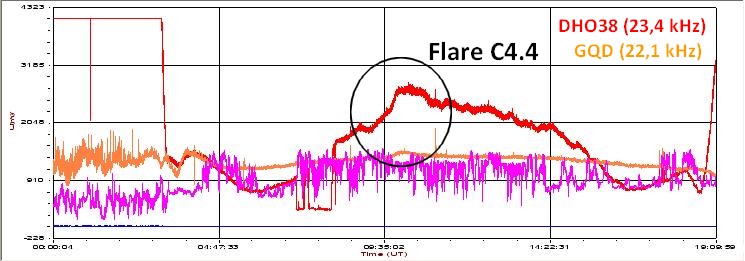
"SID" stands for Sudden Ionospheric Disturbance, and a "SID monitor"
is a radio receiver that monitors ~20 kHz signals from distant
transmitters. "My system easily detected the effects of the solar
flare," says Karlovsky. "I monitor two stations: DHO38 in Germany (23.4
kHz) and GQD in Great Britian (22.1 kHz). The German signal was most
strongly boosted."
With solar activity on the rise, sudden ionospheric disturbances will
become more common. Interested? Stanford University tells you how to
build your
own SID monitor.
|
8-14-20 - sunspots 1093 and 1099
SUNSPOT TYTONIDAE: Sunspot 1093 continues to
amaze onlookers. Earlier this week, it divided like a giant amoeba
undergoing mitosis. And "today
it looks like an owl (family Tytonidae)," reports Rogerio
Marcon of Campinas, Brasil. "What a beautiful configuration!" What's
next? Readers with
solar telescopes are encouraged to monitor developments.
Current conditions
Solar wind
speed: 408.7 km/ sec
density: 0.9 protons/cm3
explanation |
more data
Updated: Today at 2345 UT
X-ray Solar Flares
6-hr max: C1 1805 UT Aug14
24-hr: C4 1005 UT Aug14
explanation
| more data
Updated: Today at: 2340 UT
|
8-13-10 sunsots 1093, 1096. 1098
Current conditions
Solar wind
speed: 417.4 km/sec
density: 1.4 protons/cm3
explanation |
more data
Updated: Today at 1515 UT
X-ray Solar Flares
6-hr max: B1 1005 UT Aug13
24-hr: B1 1005 UT Aug13
explanation
| more data
Updated: Today at: 1515 UT
PERSEID METEOR SHOWER: The Perseid meteor shower
isn't done yet. According to the International Meteor Organization,
dark-sky observers are
counting as many as 80 Perseids per hour, including
many fireballs. The show could continue for another 12 hours or so
as Earth continues its passage through the debris stream of Comet
Swift-Tuttle.
Last night the shower was very active in Arizona. "Here
are a dozen Perseids I saw flying over the Steward Observatory on Mount
Lemmon," says astronomer David A Harvey
We also had a nice show in Norway even though the sky was still not
completely dark at 62o North!" reports Runar Sandnes.
"Meteors came sometimes in
showers of 2 or 3."
Darrell Oake of Dartmouth, Nova Scotia, adds this report: "It was a
nice clear night, the sky was filled with stars, and then--bam!--a
fireball streaked across the heavens. My son Jacoté was cold, but when
that first meteor lit up the sky, he was hooked and stayed up all night
taking in all nature could dish out."
Browse
the
gallery for more reports and images.
Key Perseid Resources:
|
8-12-10 - sunspots 1093, 1096, 1097, 1098
Current conditions
Solar wind
speed: 334.5 km/sec
density: 1.1 protons/cm3
explanation |
more data
Updated: Today at 1216 UT
X-ray Solar Flares
6-hr max: B1 1035 UT Aug12
24-hr: B2 0035 UT Aug12
explanation
| more data
Updated: Today at: 1210 UT
PERSEID METEOR SHOWER: The annual Perseid meteor
shower is underway. According to the International Meteor Organization,
dark-sky observers are now counting more than 35 Perseids per hour,
including many
fireballs. Be alert for Perseids from 10 pm on Thursday, Aug. 12th,
until sunrise on Friday, Aug. 13th. The darkest hours before dawn are
usually best.
Key Perseid Resources:
SUNSPOT TWINS: Sunspot 1093 is splitting in two.
"Pass the cigar," says photographer Alan Friedman, "it's twins!" He
sends this picture from his backyard observatory in Buffalo, New York:
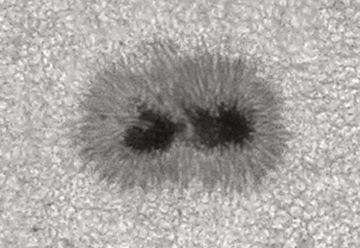
During the past 48 hours, the dark core of the sunspot has divided
itself into two Earth-sized pieces. The process resembles
cellular mitosis.
Whether this event heralds the breakup and eventual quieting of the
active region--or conversely, a multiplication of its size and
activity--remains to be seen.
Either way, "it's is a nice photo-op for astronomers with solar
telescopes," says Friedman. "Take a look!"
more images:
from Jimmy Eubanks of Boiling Springs, SC;
from Rogerio Marcon of Campinas SP Brasil;
from Pavol Rapavy of Rimavska Sobota, Slovakia;
from the Solar Dynamics Observatory in Earth orbit;
|
8-11-10 sunspots 1093, 1095, 1096, 1097
Current conditions
Solar wind
speed: 376.8 km/sec
density: 1.2 protons/cm3
explanation |
more data
Updated: Today at 2343 UT
X-ray Solar Flares
6-hr max: B1 1945 UT Aug11
24-hr: B3 1345 UT Aug11
explanation
| more data
Updated: Today at: 2340 UT
|
8-10-10 sunspots 1093, 1095, 1096
Current conditions
Solar wind
speed: 451.1 km/sec
density: 2.5 protons/cm3
explanation |
more data
Updated: Today at 2345 UT
X-ray Solar Flares
6-hr max: B1 2155 UT Aug10
24-hr: B7 1655 UT Aug10
explanation
| more data
Updated: Today at: 2340 UT
INCOMING CME: The solar eruption of August 7th
might affect Earth after all. Newly-arriving data from the Solar and
Heliospheric Observatory (SOHO) show a CME heading our way with a
significant Earth-directed component. Click on the image to launch a
"difference movie" of the expanding cloud:
The impact of this lopsided CME probably won't trigger a major
geomagnetic storm---but the SOHO data show it could be bigger than
expected. High latitude sky watchers should
be alert for
auroras when the cloud arrives probably on August 10th.
|
8-9-10 sunspots 1092, 1093, 1095, 1096
Current conditions
Solar wind
speed: 439.4 km/sec
density: 3.4 protons/cm3
explanation |
more data
Updated: Today at 2346 UT
X-ray Solar Flares
6-hr max: B1 1950 UT Aug09
24-hr: B1 0225 UT Aug09
explanation
| more data
Updated: Today at: 2340 UT
EXTRA! SOLAR RADIO BURSTS: The
August 7th flare produced intense radio bursts detectable by ordinary
shortwave receivers on Earth. In New Mexico, amateur radio astronomer
Thomas Ashcraft picked up strong emissions around 21 MHz. "Listen
to some of the sounds than came out of the loudspeakers," he says. "This
was a complex flare and very exciting. Yet it is still small stuff
compared to what is coming in the future as Solar Cycle 24 intensifies."
SOLAR BLAST JUST MISSES EARTH: On August 7th
(1825 UT), magnetic fields around sunspot 1093 became unstable and
erupted, producing a strong M1-class solar flare. Several amateur
astronomers
caught
the active region
in mid-flare, while NASA's Solar Dynamics Observatory recorded an
extreme ultraviolet movie of the entire event:
The eruption hurled a coronal mass ejection (CME) into space, just
missing a direct sun-Earth line. Forecasters expect the cloud to deliver
no more than a glancing blow to our planet's magnetic field when it
billows by on August 9th or 10th--not be a major space weather event.
Future eruptions could turn out differently. Active region 1093 is
rotating toward Earth. By the end of this weekend, we'll be in the line
of fire if its magnetic fields become unstable again.
Space Weather Phone
subscribers will be the first to know.
EXTRA! SOLAR RADIO BURSTS: The
flare produced intense radio bursts detectable by ordinary shortwave
receivers on Earth. In New Mexico, amateur radio astronomer Thomas
Ashcraft picked up strong emissions around 21 MHz. "Listen
to some of the sounds than came out of the loudspeakers," he says. "This
was a complex flare and very exciting. Yet it is still small stuff
compared to what is coming in the future as Solar Cycle 24 intensifies."
 |
|
8-8-10 sunsots 1092, 1093, 1095
Current conditions
Solar wind
speed: 395.0 km/sec
density: 2.7 protons/cm3
explanation |
more data
Updated: Today at 2345 UT
X-ray Solar Flares
6-hr max: B1 2300 UT Aug08
24-hr: B2 0750 UT Aug08
explanation
| more data
Updated: Today at: 2340 UT
|
8-7-10 sunspot 1092 and 1094
M-FLARE:
At 1825 UT on August 7th, Earth-orbiting satellites detected a
long-duration M1-class solar flare. The source of the blast was sunspot
1093. Several amateur astronomers
caught
the active region
in mid-flare.
First-look data confirm that the blast produced a CME, but the cloud is
not heading directly toward Earth. A glancing blow to our magnetic field
on August 9th or 10th might produce auroras, but this does not appear to
herald a major space weather event at Earth
SOLAR BLAST JUST MISSES EARTH: On Saturday, August 7th, magnetic fields
around sunspot 1093 erupted. NASA spacecraft and many amateur
astronomers photographed the blast, which produced a strong M1-class
solar flare and hurled a coronal mass ejection (CME) into
space--apparently just missing the sun-Earth line. The explosion also
made whooshing sounds in the loudspeakers of some shortwave radios.
Visit http://spaceweather.com for audio recordings and movies of this
latest solar event.
Current conditions
Solar wind
speed: 401.0 km/sec
density: 3.1 protons/cm3
explanation |
more data
Updated: Today at 2326 UT
X-ray Solar Flares
6-hr max: M1
1825 UT Aug07
24-hr: M1
1825 UT Aug07
explanation
| more data
Updated: Today at: 2320 UT
PERSEID METEOR UPDATE:
"The Perseids are booming here in Alabama," reports astronomer Bill
Cooke of the Marshall Space Flight Center. "Although
the peak of the shower is almost a week away, we saw five Perseid
fireballs last night (Aug. 5-6). It's a good sign that this year's
shower will be a good one." [live
meteor radar] [2009
Perseid gallery] [meteor
counts]
|
8-6-10 sunspots 1092, 1093, 1094 and 1095
Current conditions
Solar wind
speed: 421.3 km/sec
density: 3.0 protons/cm3
explanation |
more data
Updated: Today at 2347 UT
X-ray Solar Flares
6-hr max: B1
1745 UT Aug06
24-hr: B5
0135 UT Aug06
explanation
| more data
Updated: Today at: 2340 UT
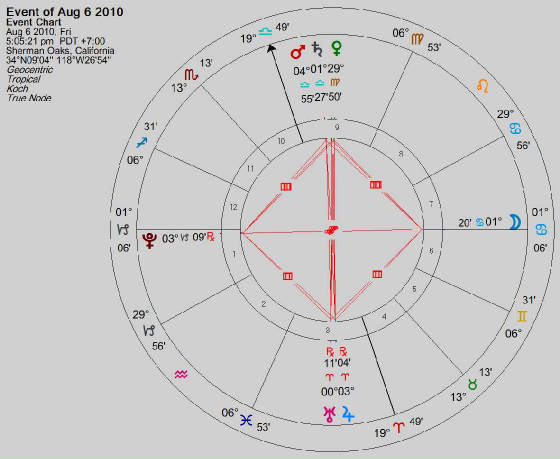
If there
is just one day when it could be said that this is the true day of
the Cardinal Climax, it would have to be this Friday, August 6,
2010. When so many slow moving planets (like Saturn, Uranus and
Pluto) are involved in a configuration (a group of 3 or more planets
in aspect to each other), it isn’t really possible to pinpoint just
one day where we can regard the transit as being the most potent. In
fact, the truth is that this type of cycle is one that actually
lasts for several years or more. They create long-term trends and
paradigm shifts that will influence all the areas of life for many
years.
Nevertheless,
even a novice can take a casual look at the chart to the right and you
will see that 7 planets are either conjunct, square or in opposition to
each other. This is not going to be seen more than once in a lifetime
for it is that rare. In a few words, this configuration creates dynamic
tension. It can be a very creative period, but it also has built into
it a great deal of resistance. It is common sense to know that the
greater the desire and/or need for change, the greater is the likelihood
of there being resistance to that very change. We can take our hints
from looking at the news and even now we see that Sen. John Kyle
(R-Ariz.) has come out for the repeal of the 14th amendment, which
allows children of undocumented immigrants to be automatically granted
U.S. citizenship. The repeal of an amendment to the constitution is a
radical change . So, we can be certain that the seeing of this now means
that the sentiments behind it are very significant and will be affecting
the political life in this country for a long time. Most things that
happen in the news right now are apt to be important. How we are
affected personally depends on where this is happening in one’s chart
and also what has been building on one’s life. It can affect one
psychologically, emotionally, physically and spiritually or in all of
the mentioned ways. On the physical plane, it could manifest as one
moving to a new city or home. It could mean that one gives birth or its
opposite that one is dealing with the death or possibly death of someone
dear to the person. Psychologically, it can manifest as the need to
confront something or someone, to face what has been important for some
time but which must now be handled. Finally, while it can create
events, it may not do so immediately.
The Planets Involved
In this
particular chart, the fast moving the Moon, Venus and Mars are acting as
triggers which stimulate whatever is in the works and this is why events
could occur at this time. The stress for action is very strong. Some
people have expressed their feeling that an earthquake here in L.A. is
coming or is likely. Such a severe event is not impossible, but that’s
not necessarily the way this energetic tension could express itself.
What it does signify is the feeling that whatever is happening now is
going to be experienced as shocking, intense and extreme. Part of the
tension is due to the geometric angles in which the planets find
themselves but it is also due to the nature of those planets. Jupiter,
the principle of expansion, philosophy, religion and spirituality is
opposing Saturn, which is the archetype of restriction, delay, but also
manifestation. Saturn is slow because it asks us to bring something into
reality, to master something and to avoid missing any steps. This can
produce frustration, but only if we try to rush something and do not
accept the necessity that things must develop naturally. And with Uranus
also involved in its conjunction with Jupiter, we see that the desire
for radical change of something can also bring about fear of that change
just as quickly.
The
Best Strategies to Deal With This Transit
Here are some
general ideas of how we might handle what is coming forward right now:
Openness to the New –
a new paradigm or structure is emerging for us right now. With it come
new challenges, but most of all it signifies some type of new set
of circumstances that we must either adapt to or with which we must
work. The famous astrologer, Dane Rudhyar, regarded this type of moment
in time as one in which a new seed is planted which will ultimately
create an entirely new plant or new cycle. (By the way, this cycle will
emerge must more clearly in the late winter and early spring of 2011
when Jupiter and Uranus enter Aries completely).
Intention –
Once we understand or can feel what the new seed is about for us, we
must then do what we can to embrace it fully, to own it, so to speak.
Whatever it is, it is coming about as a necessity, so it is best to
intend to work with it, to cooperate with its demands of us and see it
as beneficial in the long run. For some this will be easy as the new
seed is welcome, but for others, it can be resisted or even fought
against. To do so is not helpful, since the coming changes are
inevitable. We must learn to hold and even nurture the new seed, so that
as it sprouts, we do all we can to help it grow into the new structure
that is promised.
Patience –
for a variety of reasons, the changes being signaled right now are just
emerging and have a ways to go before becoming solid and clear enough to
be acted upon fully. What is more likely is that we need to approach
whatever we find ourselves being moved toward with openness, but also
without any rush. It is too big to be something that can be handled
quickly. Saturn is part of this process which means that we must not
miss any steps and must go slow enough to build a solid foundation.
Saturn provides the rules for all that develops, so respect for that
process is so important.
Awareness –
In any process that is truly new, there is an inevitable arousal of
fears since we are always more familiar with the past that we can be
with the future. The future is unknown and different, so if we find
ourselves confronting fear as the new approaches, we do not need to be
surprised or ashamed. Our job in that situation is to make the effort to
continue moving forward.
Mercury
Entering the Shadow
I will speak
more about this in the next newsletter article, but I’m mentioning it
here because it could cause delays in manifesting what the present
intense transits are bringing about. Mercury will retrograde at 19° of
Virgo on August 19, 2010, but is now in the area in which it will
retrgrade back towards, so whatever you are considering you can be
certain that there will be a review process about it. More on this in
future articles.
John
|
8-5-10 sybsoit 1092
AURORA AUSTRALIS:
Not all the lights in the sky this week were
Northern. The
geomagnetic storm of August 3rd and 4th also triggered a ring of
Southern Lights (aurora australis) around Antarctica. Australian
researcher Tom Luttrell sends
these snapshots
from Casey Base on the Antarctic coast.
MORE AURORAS IN THE OFFING?
Earth's magnetic field is still reverberating from the CME impact of
August 3rd, which sparked auroras as far south as
Wisconsin and
Iowa in the United
States. Analysts believe a second CME is right behind it, due to arrive
on August 5th. A second impact could re-energize the fading geomagnetic
storm and spark a new round of Northern Lights. High-latitude sky
watchers should
remain alert for
auroras.
At the height of the August 3rd display "the whole sky
over northern Quebec filled with green and purple," says photographer
Michel Tournay. "I couldn't decide where to point my camera!"
Fortunately, he had a wide-angle lens:
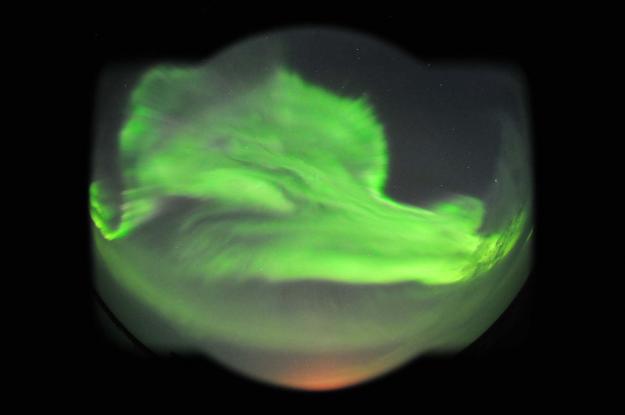
Meanwhile in Ringsaker, Norway, the auroras were
so bright "we could see them through clouds, moonlight and midnight
sunlight," says Ragnar Johnskås. "It was
a lovely show."
Browse
the gallery for
more!
EARLY PERSEID FIREBALL:
This week, Earth is entering a stream of dusty
debris from Comet Swift-Tuttle, the parent of the annual Perseid meteor
shower. We're only in the outskirts of the stream now. The shower won't
peak until August 12th and 13th when we're much deeper inside.
Nevertheless, sky watchers are already seeing some
early Perseids. This one, recorded by a
NASA meteor camera in Alabama on August 3rd, was a doozy:
On Monday night, a Perseid meteoroid, about 1 inch in
diameter and traveling at 134,000 mph, entered the atmosphere 70 miles
above Paint Rock, Alabama," reports Bill Cooke of NASA's Marshall Space
Flight Center. "Moving at such a tremendous speed, the meteor cut a path
some 65 miles long above that state, finally burning up 56 miles above
Macay Lake. It was 6 times brighter than the planet Venus--a good start
to the Perseid meteor shower!"
Current conditions
Solar wind
speed: 506.2 km/sec
density: 1.5 protons/cm3
explanation |
more data
Updated: Today at 1647 UT
X-ray Solar Flares
6-hr max: B1
1550 UT Aug05
24-hr: B2
0025 UT Aug05
explanation
| more data
Updated: Today at: 1640 UT
|
8-4-10 subspoi 1092
Current conditions
Solar wind
speed: 577.3 km/sec
density: 0.5 protons/cm3
explanation |
more data
Updated: Today at 1206 UT
X-ray Solar Flares
6-hr max: B6 0920 UT Aug04
24-hr: B6 0920 UT Aug04
explanation
| more data
Updated: Today at: 1200 UT
CME IMPACT: As expected, a coronal mass ejection
(CME) hit Earth's magnetic field on August 3rd. The impact, which
occurred around 1730 UT, sparked a polar geomagnetic storm. At the time
that this alert is being written, sky watchers in Europe as far south as
Germany are reporting red and green Northern Lights. If the storm
sustains itself for a few more hours, people in North America might see
a similar display. Sky watchers in Alaska, Canada, and northern-tier US
states such as Wisconsin, Minnesota and Maine should be alert for
auroras.
Series of Large Quakes May Be the Result
of the Sunsorm
A series of four large quakes have hit today
measuring
7.0 to 6.4 magnitudes. Scientific studies indicate a causal
interaction between charged particles such as solar flares,
cme's, and coronal holes interplay with Earth's core.
|
GEOMAGNETIC STORM--MORE TO COME? The solar storm
of August 1st sent two CMEs toward Earth. The first one arrived
yesterday, August 3rd, sparking mild but beautiful Northern Lights over
Europe and North America (see below). The second CME is still en route.
NOAA forecasters estimate a 35% chance of major geomagnetic storms when
the cloud arrives on August 4th or 5th. High-latitude sky watchers
should remain alert for auroras.
NORTHERN LIGHTS: A coronal mass ejection (CME)
hit Earth's magnetic field on August 3rd at 1740 UT. The impact sparked
a G2-class
geomagnetic storm that lasted nearly 12 hours--time enough for auroras
to spread all the way from Europe to North America. Shawn Malone of
Marquette, Michigan, photographed this display over Lake Superior:
The brightness was nice and there were quite a few
purple spikes [dancing out of] the green arc below," says Malone. "A 30
second exposure with my
Canon 5D Mark II really brought out the colors."
"Woohoo!" exclaims Canadian photographer Olivier Du Tre
of Cochrane, Alberta. "I've been dreaming about seeing auroras since I
was a boy and last night I finally did. I jumped up and down like a
little kid when I saw that green stuff on my camera's LCD screen. They
beamed
right through the clouds."
With the possible arrival of a second CME on August 4th,
tonight might be even better than last night. Imagine that as you browse
the gallery:
UPDATED:
August Northern Lights Gallery
[previous Augusts:
2009,
2008,
2007,
2006,
2005,
2004,
2003]
COMPLEX ERUPTION ON THE SUN: On August 1st, the
entire Earth-facing side of the sun erupted in a tumult of activity.
There was a C3-class solar flare, a solar tsunami, multiple filaments of
magnetism lifting off the stellar surface, large-scale shaking of the
solar corona, radio bursts, a coronal mass ejection and more. This
extreme ultraviolet snapshot from the Solar Dynamics Observatory shows
the sun's northern hemisphere in mid-eruption: Photo is above.
Different colors in the image represent
different gas temperatures ranging from ~1 to 2 million degrees K.
Watch the movie.
Some parts of the sun heat up during the eruption, other parts cool
down. These are priceless data for solar physicists working to
understand the inner workings of solar storms. Stay tuned for more
movies and analyses in the days ahead.
| |
| |
8-3-10 sunspot 1092
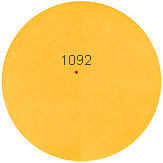
COMPLEX ERUPTION ON THE SUN:
On August 1st, the entire Earth-facing side
of the sun erupted in a tumult of activity. There was a C3-class solar
flare, a solar tsunami, multiple filaments of magnetism lifting off the
stellar surface, large-scale shaking of the solar corona, radio bursts,
a coronal mass ejection and more.
The
movie recorded by
extreme UV cameras onboard the Solar Dynamics Observatory shows an
enormous magnetic filament breaking away from the sun. Some of the
breakaway material is now en route to Earth in the form of a coronal
mass ejection (CME).
Seeing the sun erupt on such a global scale has
galvanized the
international community
of solar physicists. Researchers are still sorting out the complex
sequence of events and trying to understand why they all happened at
once. Stay tuned for more movies and analyses in the days ahead.
Current conditions
Solar wind
speed: 489.3 km/sec
density: 9.1 protons/cm3
explanation |
more data
Updated: Today at 1706 UT
X-ray Solar Flares
6-hr max: B4
1145 UT Aug03
24-hr: B4 1145
UT Aug03
explanation |
more data
Updated: Today at: 1700 UT
Solar tsunami from Sun may hit Earth on Tuesday
London, August 3 (ANI): The Earth is in
the path to be hit by a wave of violent space weather as early
as Tuesday after a massive explosion of the sun, scientists have
warned.
Astronomers witnessed the huge flare above a
giant sunspot the size of the Earth, the explosion aimed
directly towards Earth.
It sent a “solar tsunami” racing 93
million miles across space, which is likely to hit the planet on
Tuesday.
The wave of supercharged gas is likely
to spark spectacular displays of the aurora or northern and
southern lights.
However, a really big solar eruption
could shut down global communication grids and destroy
satellites, if it reaches today.
A recent warning by NASA said that
Britain could be at the receiving end of widespread power
blackouts for a long time after the earth is hit by a
once-in-a-generation “space storm”.
“It looks like the first eruption was so
large that it changed the magnetic fields throughout half the
Sun’s visible atmosphere and provided the right conditions for
the second eruption,” The Telegraph quoted Dr Lucie Green, of
the Mullard Space Science Laboratory, Surrey, as saying.
“This means we have a very good chance of
seeing major and prolonged effects, such as the northern lights
at low latitudes,” she added. (ANI)
More at :
Solar tsunami from Sun may hit Earth on
Tuesday
http://www.thaindian.com/newsportal/health/solar-tsunami-from-sun-may-hit-earth-on-tuesday_100406152.html#ixzz0vYuunT5z
|
8-2-10 sunspo - 1092
COMPLEX ERUPTION ON THE SUN:
This morning around 0855 UT, Earth orbiting
satellites detected a
C3-class solar
flare. The origin of the blast was sunspot 1092. At about the same time,
an enormous magnetic filament stretching across the sun's northern
hemisphere erupted. NASA's Solar Dynamics Observatory recorded the
action:
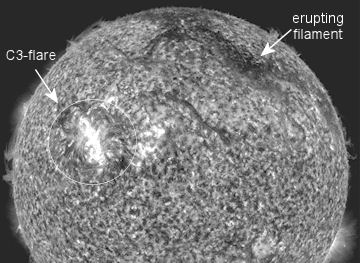
Click to launch a 304 Å movie
The timing of these events suggest they are
connected, and a review of SDO movies strengthens that conclusion.
Despite the ~400,000 km distance between them, the sunspot and filament
seem to erupt together; they are probably connected by long-range
magnetic fields. In
this movie (171 Å),
a shadowy shock wave (a "solar tsunami") can be seen emerging from the
flare site and rippling across the northern hemisphere into the
filament's eruption zone. That may have helped propel the filament into
space.
In short, we have just witnessed a complex global
eruption involving almost the entire Earth-facing side of the sun.
A coronal mass ejection (CME) produced by the
event is heading directly for Earth:
SOHO movie.
High-latitude sky watchers should
be alert
for auroras when it arrives on or about August 3rd.
more images:
from Francois Rouviere
of Mougins, France;
from Rogerio Marcon
of Campinas SP Brasil;
from Didier Favre
of Brétigny-sur-Orge, France;
from Cai-Uso Wohler
of Bispingen, Germany;
from Wouter Verhesen
of Sittard, The Netherlands;
from Michael Buxton
of Ocean Beach, California
|
8-1-10 sunspot 1092
Current conditions
Solar wind
speed: 476.4 km/sec
density: 2.0 protons/cm3
explanation |
more data
Updated: Today at 2345 UT
X-ray Solar Flares
6-hr max: B1
1745 UT Aug01
24-hr: C3 0855
UT Aug01
explanation |
more data
Updated:
Today at: 2340 UT
NEW MEXICO FIREBALL:
Dawn came early to New Mexico on Saturday around
4:54 am local time when a brilliant meteor exploded near Santa Fe. "It
turned night into day," says amateur astronomer Thomas Ashcraft who
recorded the fireball using an all-sky video camera:
must-see movie. The
movie's soundtrack is the signal from a 61 MHz forward-scatter meteor
radar also operated by Ashcraft. Ghostly echoes from the meteor's debris
continue long after the meteor itself explodes.
Listen again.
|
